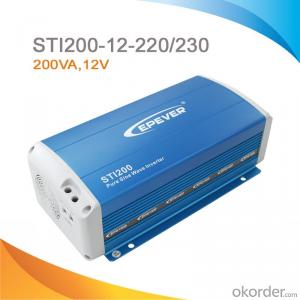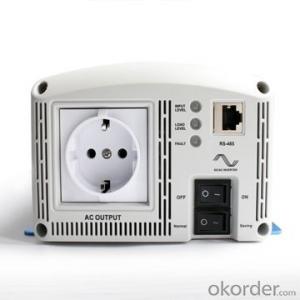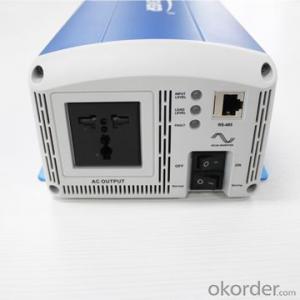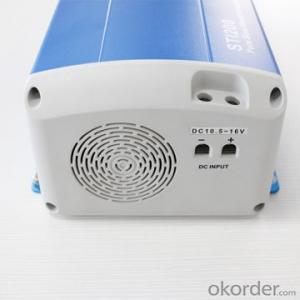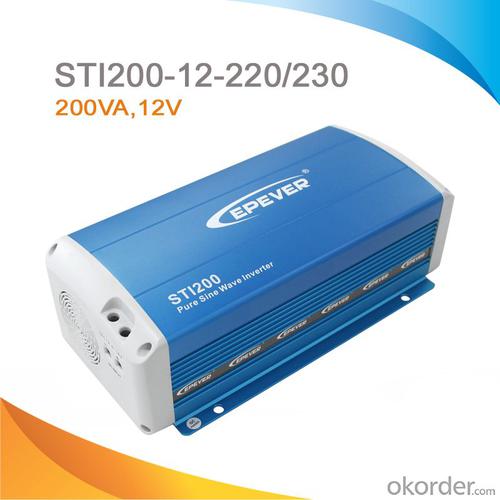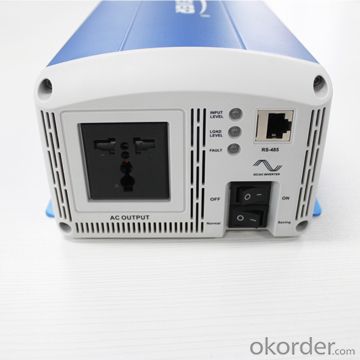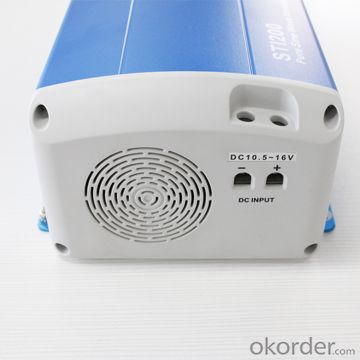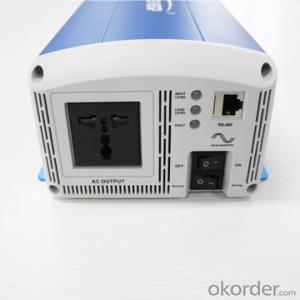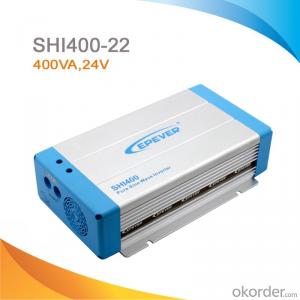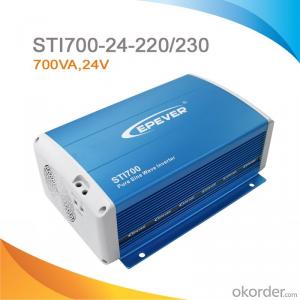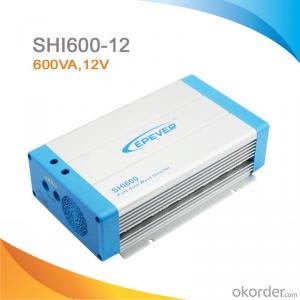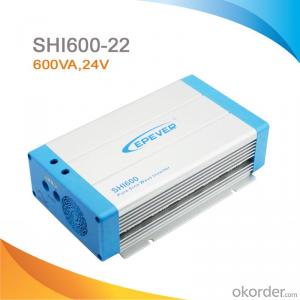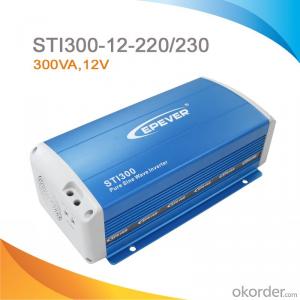Solar Inverter and Battery - Off-grid Pure Sine Wave Solar Inverter 200W, DC 12V to AC 220/230V, STI200
- Loading Port:
- China Main Port
- Payment Terms:
- TT or LC
- Min Order Qty:
- -
- Supply Capability:
- -
OKorder Service Pledge
OKorder Financial Service
You Might Also Like
Description
STI series is a sine wave power frequency inverter which can convert 12V or 24V DC to 220VAC or 230VAC 50Hz based on full digital and intelligent design. The inverter can be applied in many fields especially for solar photovoltaic power system.
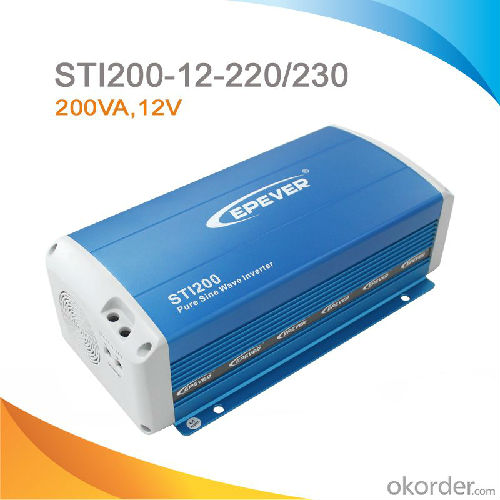
Features:
·Complete isolation-type inverter technology, noiseless output
·Adoption of advanced SPWM technology, pure sine wave output
·Dynamic current loop control technology to ensure inverter reliable operation.
·Wide DC input voltage range
·Excellent EMC design
·Low output harmonic distortion(THD≤3%)
·LED indicators display input voltage range, load power range, normal output & failure state
·Optional energy saving mode
·Wide working temperature range (industrial level)
·Continuous operation at full power
Protections:
·Output Short Circuit protection
·Overload protection
·Input reverse polarity protection
·Input low voltage protection
·Input over voltage protection
·Inverter abnormal protection
·Overheating protection

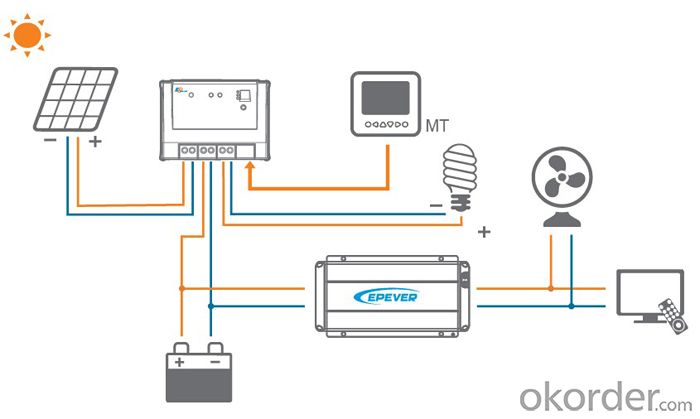
Specification:
Model | STI200-12-220 | STI200-24-220 | |
STI200-12-230 | STI200-24-230 | ||
Nominal battery voltage | 12V | 24V | |
Input voltage range | 10.5~16V | 21~32V | |
Consumption no load(ON) | ≤4W | ≤5W | |
Consumption no load (Saving) | ≤2W | ≤2W | |
Output voltage | AC220/230V±3% | ||
Continuous power | 200VA | ||
Power 10sec | 300VA | ||
Power 1.5sec | 400VA | ||
Surge power | 640VA | ||
Output mode | Single Phase | ||
Wave form | Pure Sine Wave | ||
Frequency | 50Hz±0.2% | ||
Distortion THD ( resistive load) | ≤ 3% | ≤ 2% | |
Efficiency at rated power | ≥81% | ≥85% | |
Max. efficiency | ≥88% | ≥89% | |
Dimension | 315*166*101mm | ||
Net weight | 4.5kg | ||
Working temperature | -20℃~ +50℃ | ||
Humidity | < 95%(non-condensation) | ||
Altitude | < 5000m(Derating to operate according to IEC62040 at a height exceeding 1000 m) | ||
FAQ
Does inverter long warranty mean high quality?
The European Sunny Boys are only warrantied for 5 years. iPhones only have a one year warranty. Does that mean Apple products aren't reliable? Enphase offers a 25 year warranty on their inverters but only one year on their monitoring. Does this mean their monitoring is not as reliable as their inverter? Of course not.
Offering long warranties have very real costs. If we were to offer a 25 year warranty, we would have to hold a higher reserve on our balance sheet, making our products more expensive. We think that our customers would rather have our high quality products at a lower cost.
- Q: Are there any government regulations or certifications for solar inverters?
- Yes, there are government regulations and certifications for solar inverters. In many countries, solar inverters need to comply with specific standards and regulations to ensure their safety, performance, and grid compatibility. Additionally, there are various certifications, such as UL, CE, and IEC, that solar inverters can obtain to demonstrate their compliance with the required standards. These regulations and certifications aim to promote the widespread adoption of reliable and efficient solar inverters in the renewable energy industry.
- Q: Can a solar inverter be used with a solar-powered lighting system?
- Yes, a solar inverter can be used with a solar-powered lighting system. The solar inverter is responsible for converting the direct current (DC) generated by the solar panels into alternating current (AC) that can be used to power the lighting system. It ensures efficient energy conversion and ensures compatibility between the solar panels and lighting system.
- Q: Is it possible to monitor the performance of a solar inverter remotely?
- Yes, it is possible to monitor the performance of a solar inverter remotely. Many modern solar inverters come with built-in monitoring capabilities that allow users to track and analyze the system's performance from a remote location. This can be done through dedicated monitoring portals or mobile applications which provide real-time data on energy production, system efficiency, and any potential issues or faults. Remote monitoring enables users to optimize the performance of their solar inverter, identify any maintenance or operational requirements, and ensure the system is operating at its maximum potential.
- Q: How does a solar inverter handle grid faults or disturbances?
- A solar inverter handles grid faults or disturbances by constantly monitoring the grid voltage and frequency. When a fault or disturbance is detected, the solar inverter will disconnect from the grid within a few milliseconds to ensure the safety and stability of the system. It will then enter a standby mode until the grid fault is resolved. Once the grid is back to normal, the solar inverter will reconnect and resume normal operation, providing power to the grid and maintaining synchronization.
- Q: How does a solar inverter handle voltage regulation during load changes?
- A solar inverter handles voltage regulation during load changes by continuously monitoring the output voltage and adjusting its operation accordingly. When there is a sudden increase or decrease in load, the inverter's control system quickly responds by either increasing or decreasing the amount of power it draws from the solar panels. This ensures that the voltage remains stable and within the desired range, minimizing the impact of load changes on the system.
- Q: Can a solar inverter be used in systems with multiple solar arrays?
- Yes, a solar inverter can be used in systems with multiple solar arrays. In fact, it is common practice to connect multiple solar arrays to a single inverter, especially in larger solar installations. The inverter converts the DC power generated by the solar arrays into AC power that can be used by the electrical grid or consumed directly. By connecting multiple arrays to a single inverter, the overall system efficiency can be maximized, and it allows for easier monitoring and control of the entire solar power system.
- Q: How do you calculate the maximum power point tracking efficiency for a solar inverter?
- To calculate the maximum power point tracking (MPPT) efficiency for a solar inverter, you need to compare the actual power output of the inverter to the maximum power available from the solar panels. The formula for MPPT efficiency is: MPPT Efficiency = (Actual Power Output / Maximum Power Output) * 100 The actual power output is the power being delivered by the inverter to the load, which can be measured using a power meter. The maximum power output is the highest power that can be generated by the solar panels, which can be determined by conducting a performance test or referring to the manufacturer's specifications. By dividing the actual power output by the maximum power output and multiplying the result by 100, you can calculate the MPPT efficiency as a percentage. This efficiency metric helps evaluate how effectively the inverter is tracking the maximum power point of the solar panels, ensuring optimal energy conversion and utilization.
- Q: How do you connect a solar inverter to solar panels?
- To connect a solar inverter to solar panels, you need to follow a few steps. First, ensure that the solar panels are properly installed and positioned to receive maximum sunlight. Then, connect the positive and negative terminals of the solar panels to the corresponding terminals on the solar inverter. Make sure to use appropriate cables and connectors for a secure connection. Once the connections are made, the solar inverter will convert the solar energy generated by the panels into usable electricity for your home or business.
- Q: What is the impact of a solar inverter on the overall system cost?
- The overall system cost can be significantly impacted by a solar inverter. An essential component of a solar power system, the solar inverter converts the direct current (DC) generated by solar panels into alternating current (AC) for powering electrical devices or feeding back into the grid. The cost of a solar inverter varies based on its capacity, efficiency, and brand. Generally, more advanced and efficient inverters tend to be pricier. However, investing in a high-quality inverter can lead to long-term savings and improved system performance. Considering the size of the solar power system is important. Inverters have capacity limits, so selecting the right-sized inverter is crucial for optimizing energy production and system efficiency. An undersized inverter can restrict performance, while an oversized one may result in unnecessary additional costs. The quality and reliability of the inverter are also significant factors. A well-built and reliable inverter can minimize maintenance and repair expenses, ensuring a longer lifespan for the solar power system. Furthermore, advanced features like monitoring capabilities and grid integration functionalities can enhance system performance and provide valuable maintenance and troubleshooting data, though they may increase overall system cost. Additionally, the efficiency of a solar inverter can impact the overall system cost. Higher efficiency inverters can convert more DC power into usable AC power, increasing energy production and potentially reducing the number of required solar panels. This can result in cost savings in terms of panel purchase and installation. In conclusion, while the cost of a solar inverter is an important factor in overall system cost, it is crucial to balance it with considerations such as capacity, efficiency, reliability, and additional features. Investing in a properly sized, high-quality inverter can lead to long-term savings, improved system performance, and higher energy production, maximizing the value and benefits of a solar power system.
- Q: Can a solar inverter be used in areas with high levels of lightning activity?
- Yes, solar inverters can be used in areas with high levels of lightning activity. However, it is important to ensure that the solar inverter is properly grounded and installed with appropriate lightning protection measures to minimize the risk of damage caused by lightning strikes.
Send your message to us
Solar Inverter and Battery - Off-grid Pure Sine Wave Solar Inverter 200W, DC 12V to AC 220/230V, STI200
- Loading Port:
- China Main Port
- Payment Terms:
- TT or LC
- Min Order Qty:
- -
- Supply Capability:
- -
OKorder Service Pledge
OKorder Financial Service
Similar products
Hot products
Hot Searches
Related keywords
